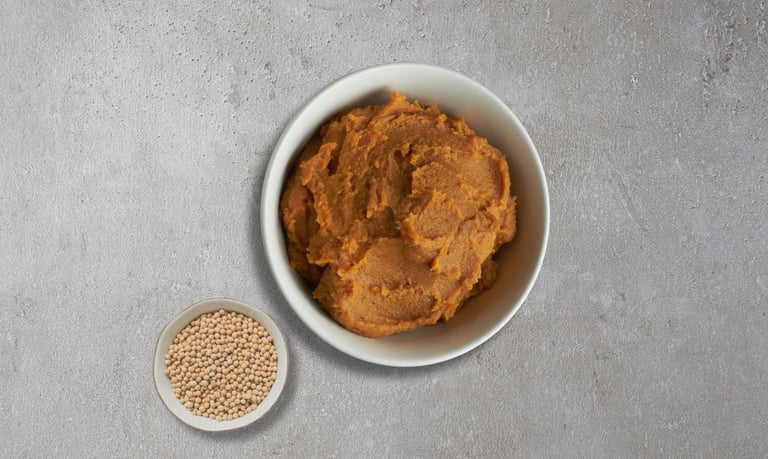Miso and Umami: The Fermented Flavor That Adds Soul to Cooking
FOODTASTING NOTES


A teaspoon can turn water into broth. A tablespoon can transform vegetables into something memorable.
There’s a quiet revolution happening in our kitchens, and its secret weapon is miso. Once reserved for Japanese soups and marinades, this humble fermented paste is now showing up in cookies, cocktails, and even caramel. It’s the ingredient that adds depth without drama, a flavor note that doesn’t shout but lingers long after the last bite. In a world obsessed with flavor, miso is having a moment. And it’s well deserved.
What exactly is miso?
At its core, miso is a fermented paste made from soybeans, salt, and koji, a type of mold used to break down grains and starches. Sometimes, grains like rice or barley are added, depending on the style or region. Its roots go back centuries in Japan, where it was a staple of daily life and a rich source of nutrition. Today, it’s making its way into home kitchens and restaurant menus around the globe.
Think of it as a natural umami enhancer. A teaspoon can turn water into broth. A tablespoon can transform vegetables into something memorable.
The flavor spectrum: Which miso is right for you?
Like chocolate or coffee, miso isn’t just one flavor. The taste changes depending on the type of grain used, how long it’s fermented, and where it’s made.
White Miso (Shiro Miso)
This is the gateway miso. Light in color with a gentle, almost sweet flavor, it’s great for salad dressings, glazes, and even baking. It’s fermented for a shorter time and usually made with rice koji.
Yellow Miso (Shinshu Miso)
Slightly more fermented than white miso, this style strikes a balance between sweet and savory. Many yellow misos are made with soybeans and rice koji, though some traditional versions also include barley. Always check the label if you are avoiding gluten.
Red Miso (Aka Miso)
Bolder and saltier, red miso is fermented for a longer time and has a deeper, funkier flavor. Use it in rich soups, glazes, and braises.
Barley Miso (Mugi Miso)
Made with barley koji, this regional variety has a slightly nutty, earthy taste and works well in heartier dishes.
Sweet meets salty: Unexpected miso pairings that work
One of the most exciting things about miso is how well it pairs with sweet flavors. A small spoonful can bring out the richness in sugar or chocolate in a way that feels fresh and modern.
Miso + Brown Sugar: Add white miso to your chocolate chip cookie dough, and the brown sugar (the flavor of 2025) tastes warmer and deeper.
Miso + Dark Chocolate: A pinch of red miso in chocolate cake or ganache creates a mysterious, earthy richness.
Miso + Coffee: Try miso caramel in your cold brew or espresso-based drinks for a subtly savory twist.
This balance of salty and sweet is what makes miso so addictive. It lingers on your palate and keeps you coming back for more.
How to start using miso at home
Don’t be intimidated by miso. It’s easy to use and keeps well in the fridge. Here’s how to make it part of your routine:
Pick the right kind of miso for you: White or yellow miso is best for beginners. Look for it in tubs or pouches in the refrigerated section of Asian grocery stores or large supermarkets.
Check the label: If you’re gluten-free, choose one that uses rice instead of barley. Many brands note this on the packaging.
Store it properly: Keep miso tightly sealed in the refrigerator. Thanks to its salt content, it can last for up to a year.
Use it like a seasoning: Mix a spoonful into soups, spread it under chicken skin before roasting, stir it into mashed potatoes, or whisk it into salad dressings.
Pro Tip: One of the easiest ways to try miso? Make a simple miso butter. Combine softened unsalted butter with white miso and a squeeze of lemon juice. Use it on toast, vegetables, steak, or seafood. It’s a small effort that delivers big results.
Miso isn’t flashy. It doesn’t trend like burrata or go viral like pistachio. But it has staying power. It’s the quiet cornerstone of many unforgettable meals. Whether you’re building a savory soup or trying something new with your favorite cookie recipe, miso adds depth and personality in a way few ingredients can match. Once you start experimenting with it, you’ll wonder how your kitchen ever felt complete without it.
Disclaimer: The recipes and food recommendations in this article are for general inspiration and enjoyment. Since dietary preferences and restrictions vary, we recommend consulting with a nutritionist or dietitian if you have specific dietary concerns or health conditions.. Please note that ingredient availability and cooking times may also vary based on location and personal preferences. This article may also contain affiliate links, meaning we may earn a small commission if you make a purchase through them at no cost to you. We are also part of the Amazon Associates program.
